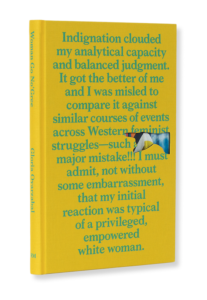In the article The best photography books of 2020 at ElPaís, Gloria Crespo Maclennan asks various cultural professionals to recommend their two favorite photography books of 2020.
We share with you the recommendations of Rocío Santa Cruz:
Woman Go No’Gree deGloria Oyarzabal.RM. 176 pag

With this book Gloria Oyarzabal has just won the prestigious Paris Photo-Aperture 2020 Best Book of the Year award. Carefully edited and with an innovative, risky and at the same time very beautiful graphic design, the artist draws up an excellent dialogue around the deconstruction of the idea of the gaze and “the other”. She explores, through the use of found images, archives, and her own photography, colonialism and white feminism in West Africa. Her images, fleeing from “exoticism”, dilute the lines that separate photojournalism from artistic and conceptual photography. According to the author, “it would be a question of decolonizing feminism by questioning the Eurocentric rational theoretical frameworks that construct gender categories in a universalist way.” Through her own photographs and the historical documents that he colors, Oyarzabal challenges us to face our own prejudices and assumptions.
Get the book here in the ArtsLibris online store.
La caja roja de Antoni Campañà. Comanegra. 328 pag.

Antoni Campañà was born in Arbúcies (Girona), in 1906, along with Photojournalism, a field in which he earned a well-known reputation as sports reporter and pioneer of the tourist postcard. Before the age of thirty, Campañà had achieved national and international recognition for his refined mastery of bromoleum techniques. In the years before the Spanish Civil War, he received numerous awards and consolidated his position as an artist. In 1933 he travelled to Munich to train with the photographer Willy Zielke He carried out an impressive body of work involving experimentation and innovation, thus transcending the parameters of pictorialism and becoming an unparalleled reference point for experimental photography in Spain. During the years of the Civil War, Campañà took more than 5,000 photographs. He portrays a tragic and contradictory reality, with which he traces a huge frieze of unpublished images of the highest quality that he buries in the garage of his house at the end of the war. His visual testimony remained hidden for decades. Thirty years after his death, his family found the pictures stored in red boxes, which are now brought together in La caja roja